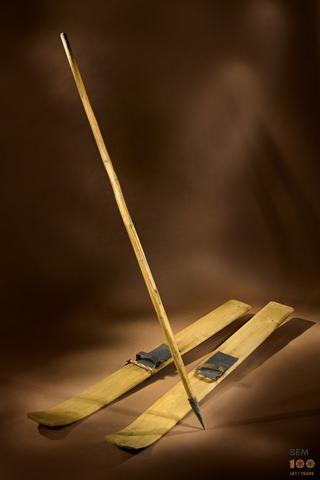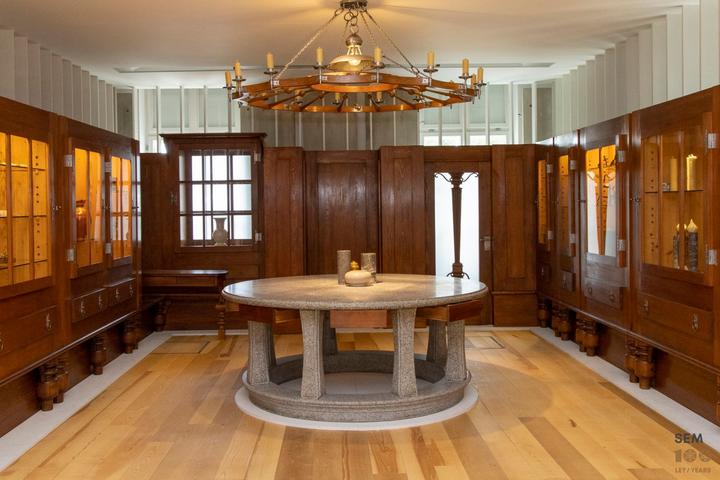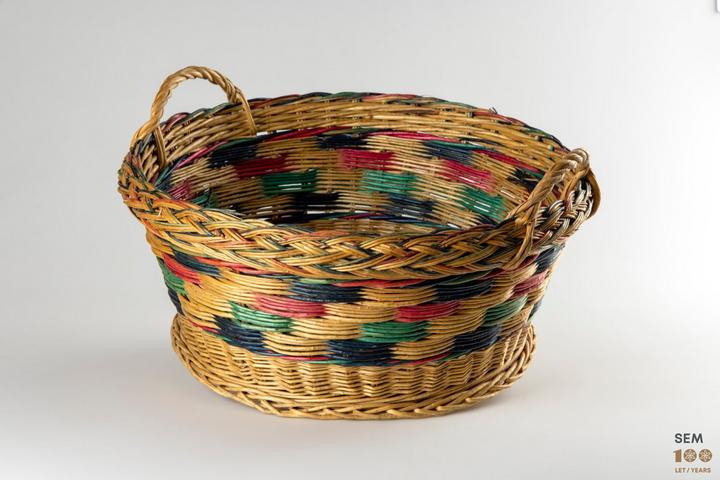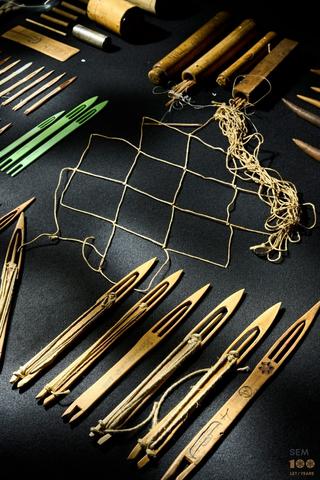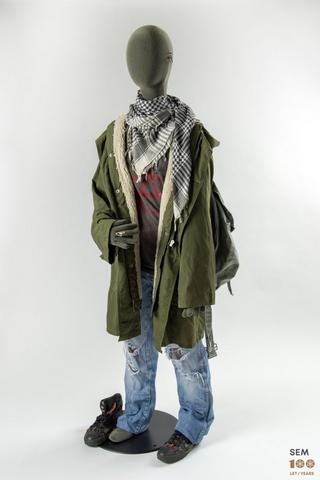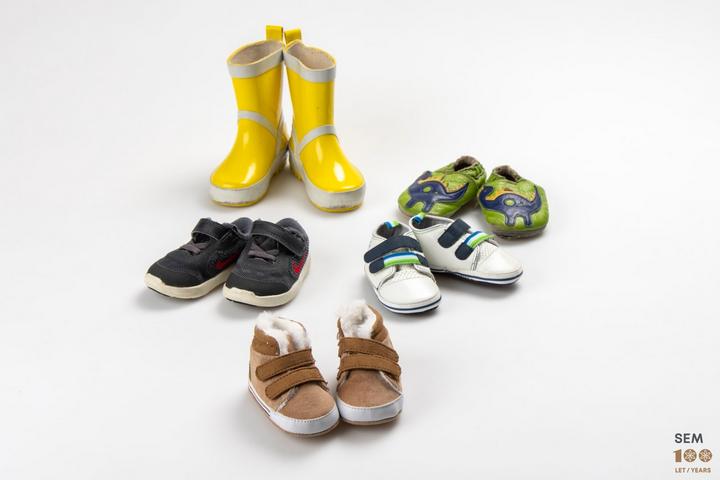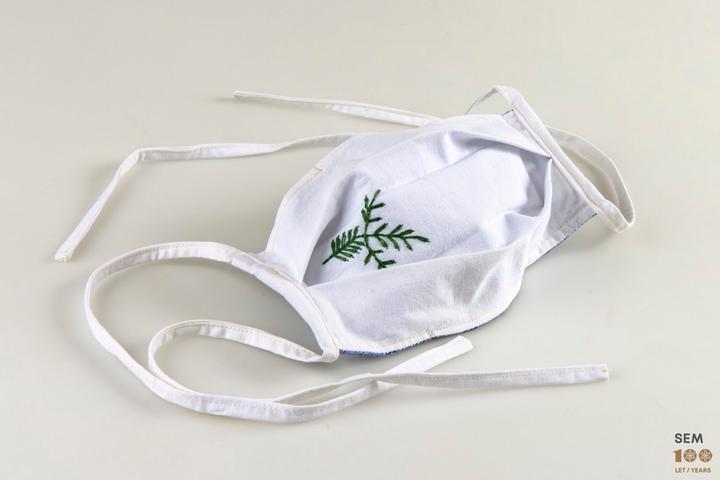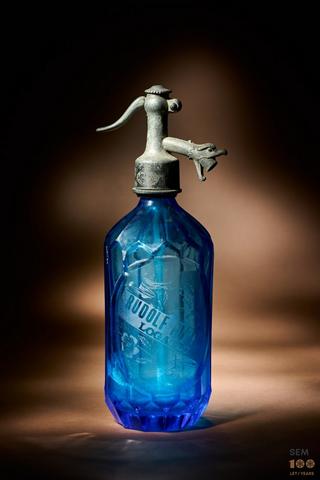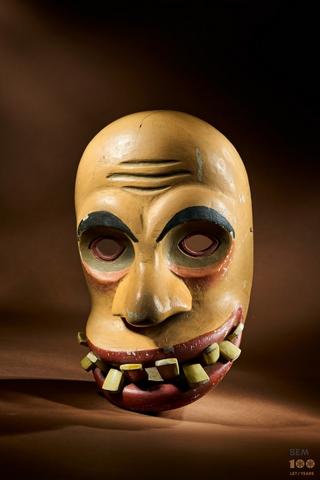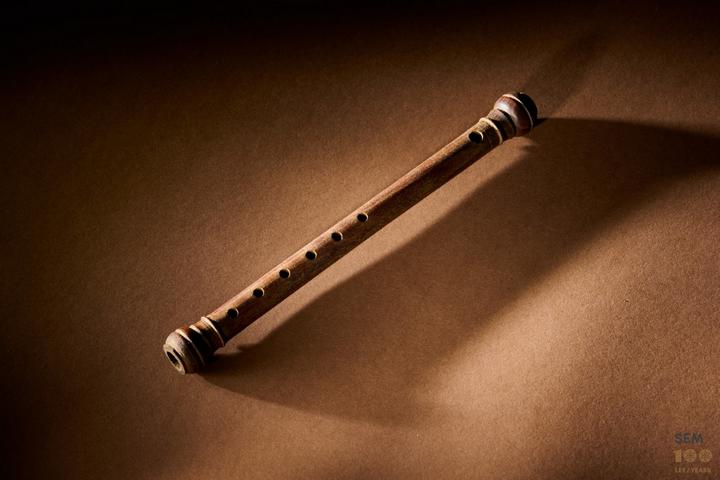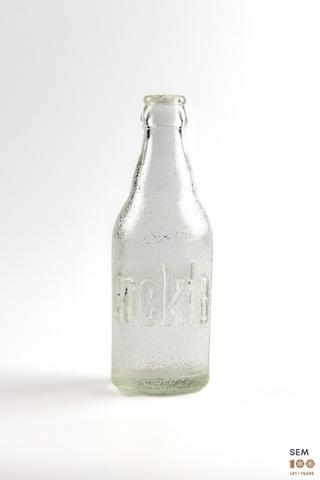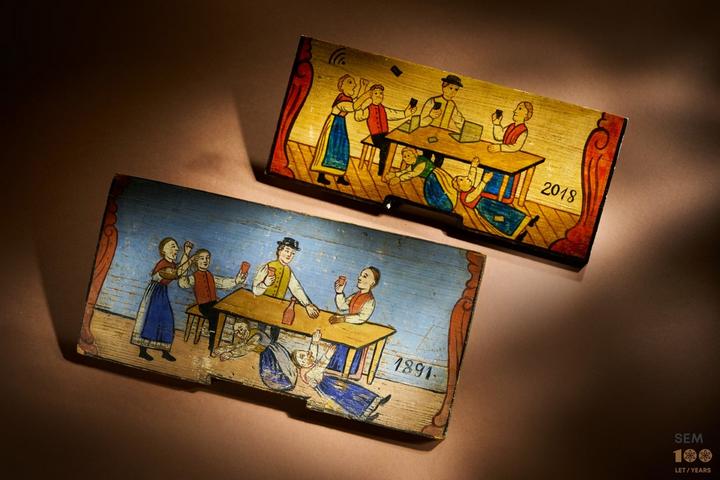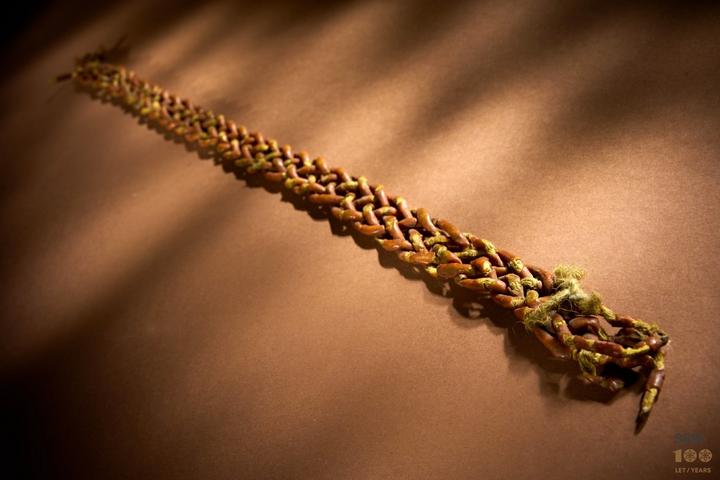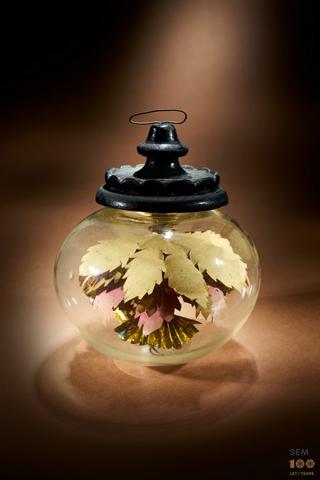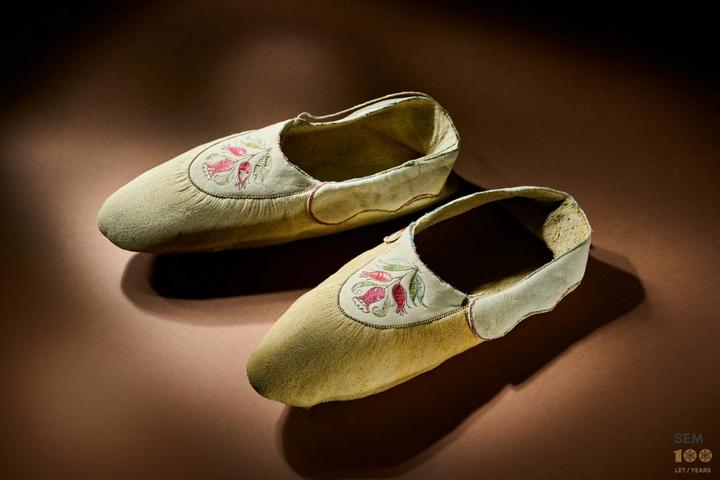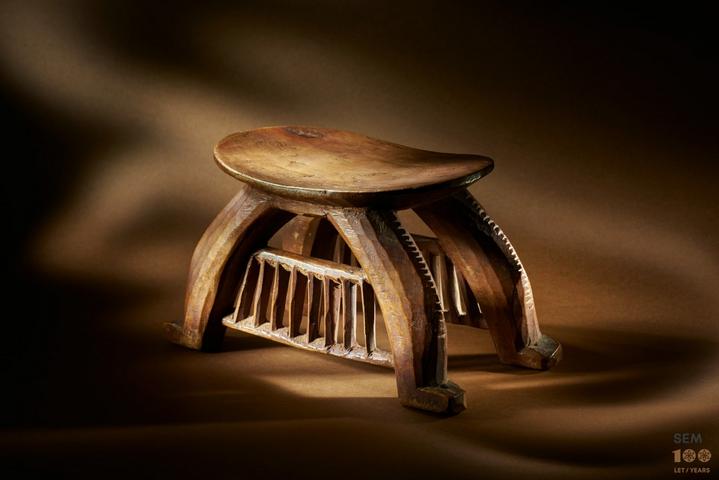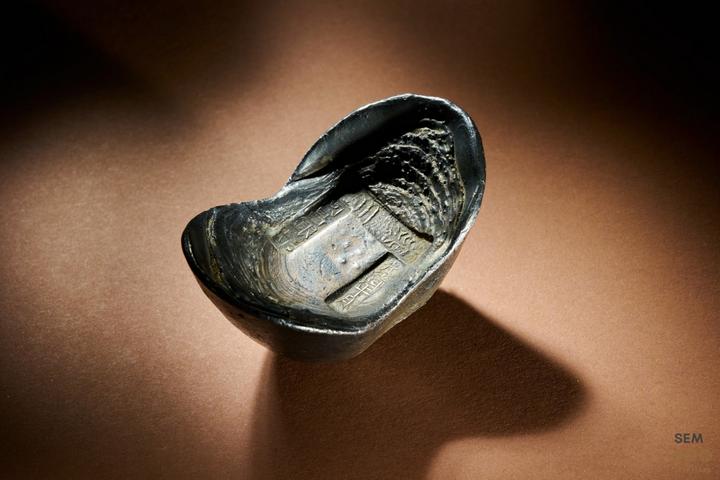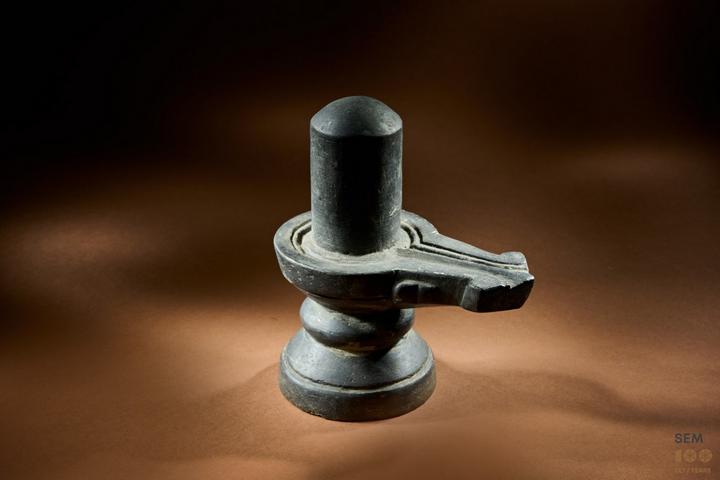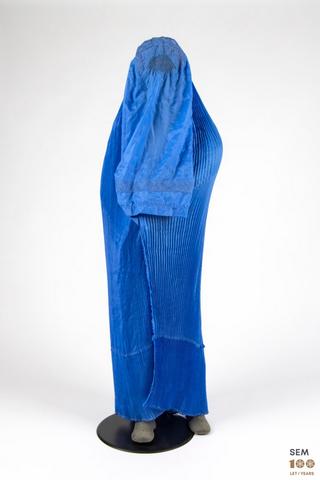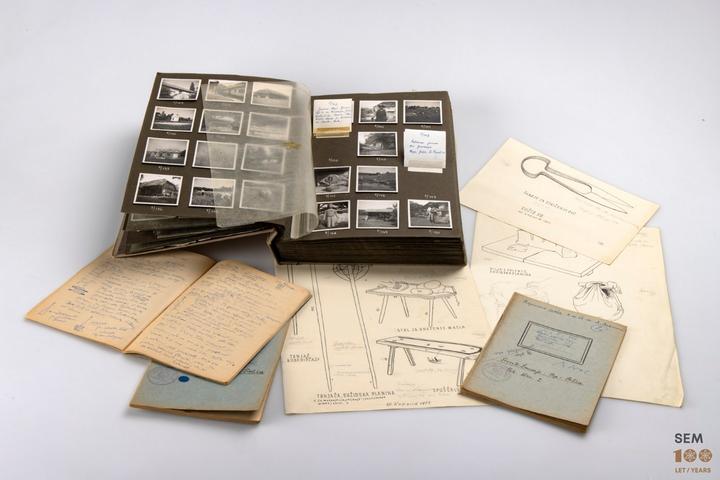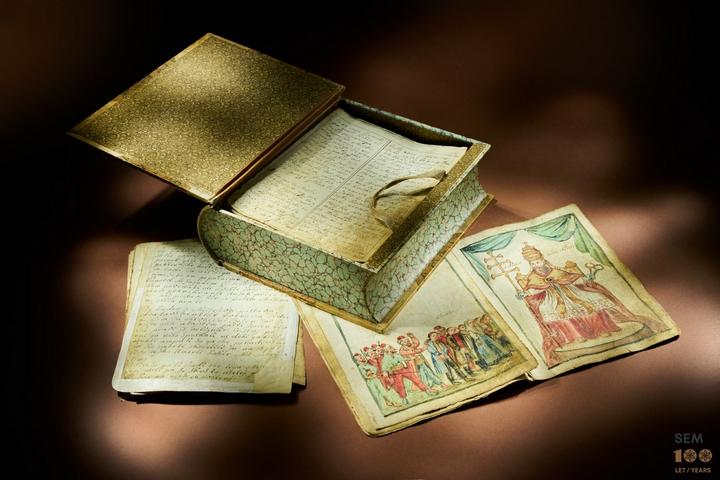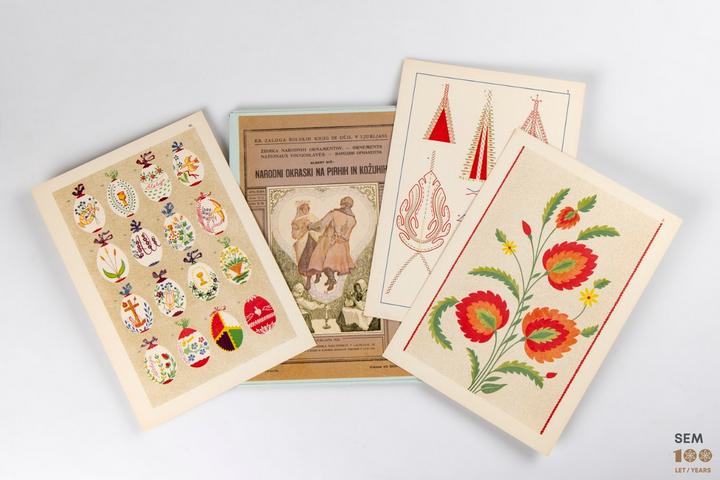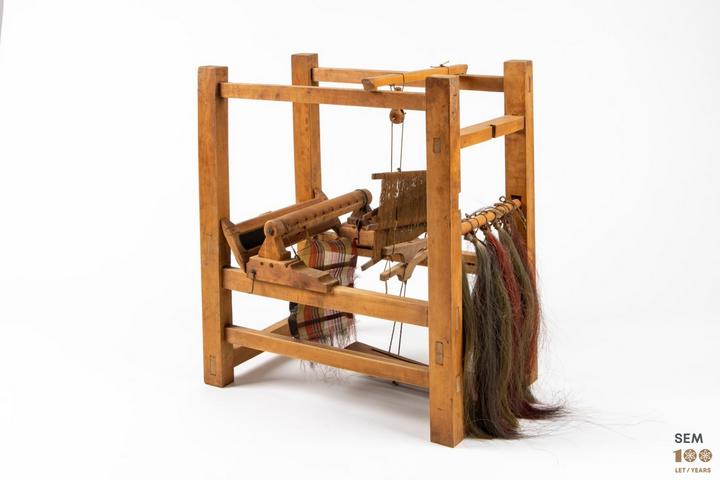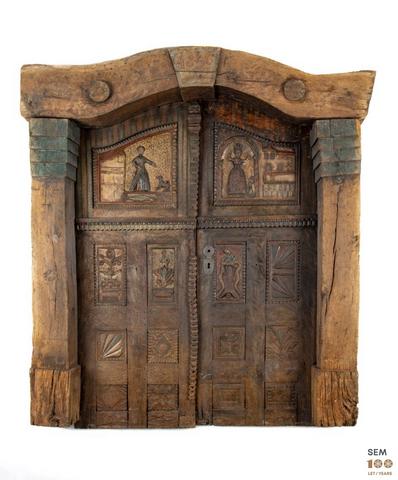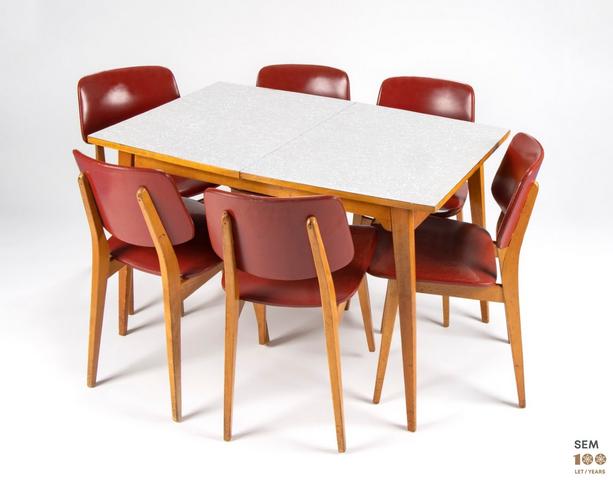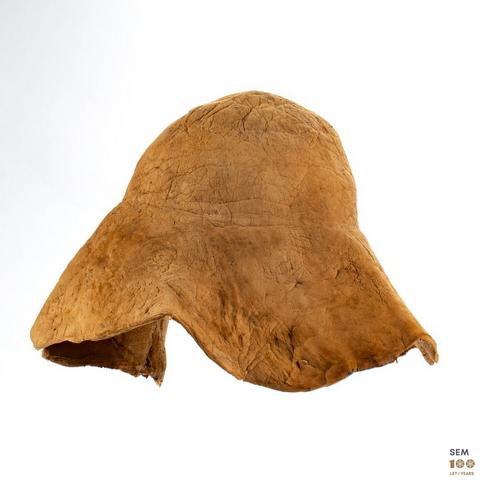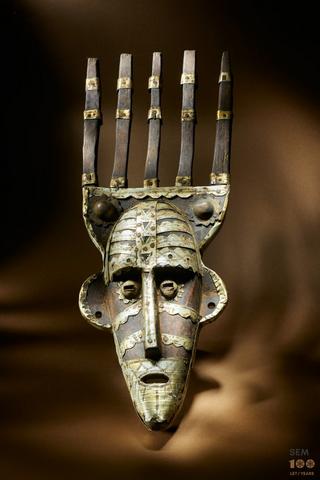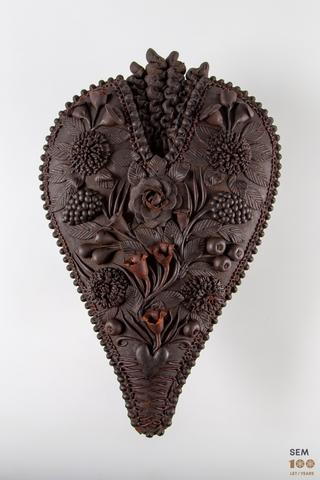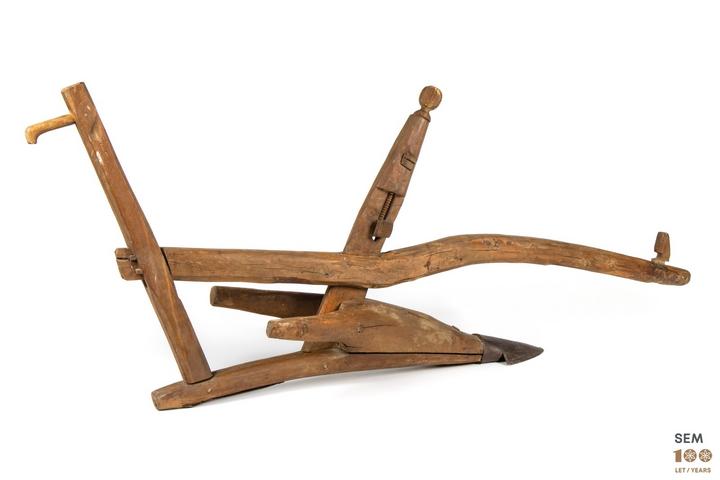100 objects from the SEM collections
100 years - 100 objects
In the festive year, we present selected 100 museum objects, which show the richness and diversity of the collections of the Slovene Ethnographic Museum.
1
Double yoke, Hočevje, Dolenjska, acquired 1960.
The museum keeps a representative collection of yokes, which is renowned also outside Slovenia. Among them, due to being well preserved and richly decorated, is the Mediterranean type of yoke made of maple wood from the "p'r Hrenovk" farm in Hočevje, This type of yoke was used in central Slovenia and in the Mediterranean area. It was acquired for the museum collection by a SEM field team.
Department of the Rural Economy and Transport
2
Bloke skis, Zavrh, Notranjska, acquired in 1956.
Villages on the Bloke plateau and Sveti Vid Hills lie at an altitude of between 700 and 900 metres and are known for severe winters, and are considered to be the cradle of skiing in Central Europe. The locals used skis for moving across snow.
The skis made of ash wood are 153 cm long, have a felt base for shoes, leather straps for attaching the shoes and a stick for support. They were acquired by Dr Boris Orel, who created a collection of Bloke skis.
Department of the Rural Economy and Transport
3
Furniture and fittings in the Lectarija shop, Ljubljana, made in 1939.
The furniture and fittings of Lectarija, a shop selling domestic arts and crafts, was made following plans by the Slovene architect Jože Plečnik. He drew the plans in 1938, while the shop in Ljubljana centre was opened by its owners Henrieta Krbavčič and Robert Freyer a year later. The items include wooden display cabinets, a small table and bench, a round table made of artificial stone, a round wooden chandelier with candles, a door and a shop window with a brass spiral. Lectarija sold high quality handicrafts. After World War Two, the shop was managed by the company Dom. SEM acquired the furniture and fittings in 2000.
Department of Crafts and Trade
4
Round basket, Reteče near Škofja Loka, made in 1970.
The round basket with a flat bottom and two small handles is manually woven from bleached and colourful willow canes and finished at the top with a thick plait. It is doubly interwoven, including the bottom. The basket was made in 1970 by the basket weaver Frančiška Hrastar from Reteče near Škofja Loka. These baskets were used by women to carry things on their heads, first they put a ring on their head and then placed the basket on top of it.
Department of Crafts and Trade
5
Tools for sewing nets, making rope and for fishing, Nabrežina/Aurisina near Trieste, 19th century.
The family collection of furniture and fittings, tools used for fishing, working the soil and stockbreeding, and personal objects belonging to four generations of the Caharija family is the fruit of many years of cooperation between the SEM and this fishing family. The collection was acquired in 2018 alongside the exhibition The Sea of Our Lives: Memories of a Nabrežina/Aurisina fishing family. It is an important source for studying a way of life among the Slovene fishing families in the Trieste Littoral. At the same time, it attests to materialised memories that are like anchors of diverse identities.
Department of Architecture, Inner Equipment and Dwelling Culture
6
Everyday clothing of a secondary-school girl, Ljubljana 1990s
One of the more complex approaches to collecting each contemporary period is the acquisition of clothing combinations from the same wearer, if possible accompanied by first-person notes about acquiring, combining and altering individual items of clothing and accessories into an everyday outfit. An example of this is the outfit, assembled from her old clothes by D. K. born in 1980, showing how she built her punk image at the time.
Department of Clothing Culture and Textiles
7
Sever collection, Ljubljana, 2017–2019.
The “emerging collection” is the result of agreed long-term collecting and ongoing inclusion in the collection. In this way, there a collection develops of all the no-longer worn footwear from the same wearer, S. G., born in 2017, from his birth onwards. It is an illustrative document of quantity, facilitating insight into the use and discarding of footwear. An added value of such a gradual collection is attention directed at the “experience from the inside of a shoe”.
Department of Clothing Culture and Textiles
8
Protective mask with an embroidered olive branch, Sv. Peter near Sečovlje, made in 2020.
The protective mask is made of an old sheet and mattress cover. During the lack of protective medical masks, it was intended to protect against infection with covid-19. Every year, the maker of the mask weaves olive palms from olive branches, which are carried in Slovenian Istria on Palm Sunday to be blessed in church. Since in 2020, due to the covid epidemic, there were no blessings, she embroidered an olive palm onto this protective mask.
Department of Social Culture
9
Soda bottle, Logatec, early 20th century
The soda bottle is made of solid blue glass. This type of bottle was filled by Rudolf Puppis from Logatec with soda water, a fizzy drink made from water mixed with carbon dioxide. In 1904, he opened a general store and an off-licence in Logatec, while in 1906 he began to fill and sell bottles of soda water. After his death in 1923, the filling and selling of soda water was taken over by Miroslav Puppis.
Department of Social Culture
10
The face mask of ta terjasti Shrovetide carnival character, Cerkno, made in 1938.
The face mask made of a single piece of lime tree wood was carved by Avguštin Hadalin and belongs among the oldest Shrovetide masks in the SEM collections. Ta terjast is one of the most recognisable Shrovetide characters among the Cerkno laufarji carnival group. Its name is based on the clothing and head gear, covered in terje (remnants left over after weaving linen). In 1956, after over four decades, the Cerkno laufarija carnival was revived and all fourteen characters restored. Now, the group consists of 25 characters, who represent professional and social groups and personify human characteristics.
Department of Spiritual Culture
11
Žvegla, Sedlašek near Podlehnik, made in the late 20th century
Žvegle are flutes of the transverse type, encompassing two octaves. They are made (turned) from one piece of box, plum or pear tree wood. With regard to their size, žvegle are identified by numbers. The smallest one is number one (around 20 cm), the biggest number nine (can be longer than 50 cm). Number eight and nine, to facilitate production, can be made of two parts. The žvegle from the SEM collection were made by Izidor Cafuta in the 1990s.
Department of Spiritual Culture
12
Cockta bottle, Ljubljana, 1953.
These bottles were used for the drink Cockta, the first fizzy non-alcoholic drink in Yugoslavia. The company Slovenijavino offered this drink for the first time at the ski-jumping competition in Planica in 1953. The name Cockta is connected to the word cocktail since it is a mixture of the extracts from rosehip, lemon and a series of medicinal herbs. The bottle was designed by the architect Sergej Pavlin.
Department of Spiritual Culture
13
Decorated beehive panels, depicting a Wife Dragging her Husband from his Drinking Companions, Selca workshop, Selca in the Selca Valley, 1891, and Kim Badawi, Ljubljana, 2018.
The collection of painted beehive panels is supplemented with a specimen of the modern interpretation of the motifs. While discovering his Slovene roots, Kim Badawi, born to a father of Egyptian origin and a mother who is half Slovene and a descendant of an aleksandrinka (Slovene women who from the second half of 19th century went to work in Alexandria, Egypt), became enthusiastic about beekeeping, particularly about the messages conveyed by the painted beehive panels. The panel depicting a wife dragging her husband away from his drinking companions is his and uses modern world symbols (Twitter, Microsoft ...) to interpret the image from a beehive panel in the SEM collection.
Department of Folk Art and Pictorial Sources
14
Head wreath – votive, Drtija, 18th or 19th century
The object made of waxed knitwear is almost certainly a votive wedding wreath for the head. The fact that it is cut, hints at the wedding custom in which the groom symbolically cut the wreath on the bride’s head. Janez Vajkard Valvasor reports on this in his Glory of the Duchy of Carniola (1689), when describing the wedding customs around Pivka. In the 19th century in Central Europe, uncut votive wreaths worn on the head were used to alleviate headache.
Department of Folk Art and Pictorial Sources
15
Holy Spirit in a glass sphere, Selca in the Selca Valley, early 20th century
Religious statues, which include the depiction of the Holy Spirit, became established in Slovene farms in the 19th century. Doves as the symbol of the Holy Spirit were hung over the table in the main living area. They were hung on strings; if the string was connected with the door, the dove was lowered and lifted. The self-taught carvers made them from wood, but sometimes they were made of paper, a piece of bark into which feathers were stuck, from straw, cotton wool or gilled polypore (Trametes betulina). Visually attractive and rather rare are paper doves in a glass sphere.
Department of Folk Art and Pictorial Sources
16
Pair of moccasins, North America, first half of 19th century
Moccasins were a characteristic leather footwear of North-American peoples. The pair of moccasins from the Baraga collection is made of red-deer leather, the top part of the shoe is decorated with a vegetational motif. The embroidery is made with porcupine spines, coloured with plant and mineral substances. The moccasins were never worn as they are unfinished. One moccasin has only a sketched image of a flower on top, which was to be made from the spines, while the other does not even contain a drawing.
Department of Collections from Africa and America
17
Stool, southern Sudan, first half of 19th century
The stool from the Knoblehar collection made by the Bari people, which was also used as a pillow, is carved from a single piece. The oval seat is slightly arched. The four legs are connected in pairs with two crossbars. Between them there are eight vertical supports. The crossbars had a magical effect, protecting the owner from nightmares during sleep. The shape of the legs has an anthropomorphic character, since it imitates a human leg and foot. Bari stools resemble the Slovene pručka stool.
Department of Collections from Africa and America
18
Silver ingot – Chinese money, China, Yuan dynasty, (1271–1368).
The minted silver ingot (yuanbao 元寶) originates from the period of the Mongol Yuan dynasty (1271–1368), when money printed on paper made of cotton fibres and mulberry bark was mostly used for payment. Coins from the time of Yuan dynasty are therefore fairly rare since they were minted in addition of the printed paper money to a much lesser extent than during other dynasties. The ingot is part of the Skušek Chinese collection that came to the SEM in 1964.
Department of Collections from Asia, Australia and Oceania
19
Lingam, India, made in early 20th century
Lingam or linga (Sanskrit: “sign” or “distinguishing symbol”) is a protective object in Hinduism, which in the form of a phallus symbolises goddess Shiva and is worshipped as an emblem of generative power, often resting in the middle of a yoni or vulva, which symbolises the goddess Shakti. Lingams appear in Shaivism temples and private temples throughout India. It is part of the Indian Bengal collection, which came to the SEM from the Federal Collection Centre in 1948.
Department of Collections from Asia, Australia and Oceania
20
Burka, Afghanistan, made in early 21st century
A hundred years ago, burkas in Afghanistan were very rare and different from those today, and fifty years ago they were rarely seen. The present-day burka is a direct expression of the conservatism of Afghan society. During the first Taliban rule (1996–2001), women were ordered to wear one. During the second Taliban rule (2021-), on May 7 2022, the authorities again declared that women must wear a burka. The burka symbolises the patriarchal suppression of women in Afghanistan, but it can also be a “withdrawal” from curious and “lustful” men’s eyes. The museum acquired it in 2011.
Department of Collections from Asia, Australia and Oceania
21
Photographic album, freehand drawings and notebooks with field notes, 1949–1951.
The extensive Orel field teams material includes photographs, negatives, freehand drawings and field notes, which appeared between 1948 and 1982 in selected parts of Slovenia.
Documentation Department
22
Antichrist, early 19th century
An example of the valuable material in the House Archives is Antichrist, a manuscript from the early 19th century with 453 pages and 78 colour illustrations.
Documentation Department
23
Albert Sič folders.
In 1922 and 1923, in the spirit of the time when amateur ethnographers were striving for the establishment of a national style, the first and second volumes of the Collection of National Ornaments were published. Due to the rich pictorial material they contain, the so-called Sič folders continue to be interesting a century later and one of the most frequently borrowed materials in the SEM Library.
The Slovene Ethnographic Museum Library
24
Model of a loom for making sieve mesh with a horsehair sieve, Stražišče pri Kranju, made in 1833.
The model of a loom for making sieve mesh is one of the oldest objects in the SEM collection. In 1833, Ignac Valenčič, a vicar in Stražišče near Kranj, sent to the Carniolan Provincial Museum in Ljubljana a loom for making sieve mesh from horsehair, made according to his own design and half size. He was responsible for the technical improvements to the loom – he placed on it a cylinder, on which the woven horsehair mesh was wound, making the weavers work much easier.
Department of Crafts and Trade
25
Front door of a house, Gradenc near Žužemberk, 19th century
The door has a typical wooden yoke-shaped portal with the year 1856. The carved and coloured oak doors bear many motifs: St. Roch, Mary crowned, St Blaise, floral and animal, geometric and architectural. The object attests to an important symbolic and aesthetic role of doors as the junction between a home and the wider community. Judging by the preserved photographs, there was in the same village at least one other door by the same maker. Nowadays, older doors in Gradenc are rare and in bad condition. The museum object is important for research into the architectural heritage of the Suha Krajina region.
Department of Architecture, Inner Equipment and Dwelling Culture
26
Dining table with chairs, part of the living room of the Langerholc family, Ptuj, 1960s. (an illustration of the ambience of the exhibition Us at the Table)
A complex presentation of dwelling culture demands a directed collecting policy through the acquisition of sets of furniture from different rooms in the same home. The attention here is directed at the way dwelling is structured and the attitude of the owners to individual objects and their meaning in their home. The acquired sets are supplemented with notes or narratives by the people who have given them. The museum acquired the dining table with chairs (manufactured by Stol Kamnik) as part of the living room of the family of Rado Langerholc, a Ptuj photographer, together with some of the family’s written correspondence, photographs and personal objects.
Department of Architecture, Inner Equipment and Dwelling Culture
27
Man’s working hat made of tinder fungus, unknown origin, 19th century
The soft hat is made by manual reshaping of the tinder fungus (Fomes fomentarius), supposedly for the maker’s own use. It offered basic protection for the head from the sun, rain, dirt and sweat, and was therefore suitable when working. Since it had no aesthetic or status importance, it belongs among the rarely preserved specimen of this type in museum collections. It perhaps becomes interesting for us today only because of unsuccessful attempts to reconstruct the technique used in making it.
Department of Clothing Culture and Textiles
28
N'tomo mask, Mali, second half of 20th century
The wooden mask from the Jerovšek collection, decorated with cowrie shells and red seeds, was used by the Bambara people in Mali while accompanying underage boys during their initiation ritual. The use of cowries gives the mask an archaic appearance, reminiscent of ceramic masks of Mediterranean pre-historic cultures. The shiny gloss of the cowries has an apotropaic magical meaning and protects the dancer from dangerous invisible demons.
Department of Collections from Africa and America
29
Small bread, Železniki, made in 1896.
Small bread is honey pastry, characteristic of the Škofja Loka area. It is made by pressing dough into wooden moulds or shaping them by hand. In the SEM collection we keep small breads in different shapes, made in both ways. Most are small breads in the shape of a heart and round loaves. This small bread from Železniki was made by hand, most likely for a wedding. The SEM acquired it from the Carniolan Provincial Museum.
Department of Social Culture
30
Rectangular primitive plough with wheels, Matkov kot, Štajerska, acquired in 1957.
Primitive ploughs were already I use in Slovene lands a few centuries BC, in the 10th and 11th century they were replaced by ploughs that not only break, crumble and loosen the soil, but also turn it. In the hilly parts of Štajerska and Koroška, primitive ploughs were preserved until the 20th century for secondary use, e.g. for digging up potatoes. This primitive plough made of hardwood and iron was still being used for a few years after World War One. After World War Two, the SEM deliberately collected farming tools, including ploughs, which represent one of the richest collections of this kind in the wider Central European space.
Department of the Rural Economy and Transport


